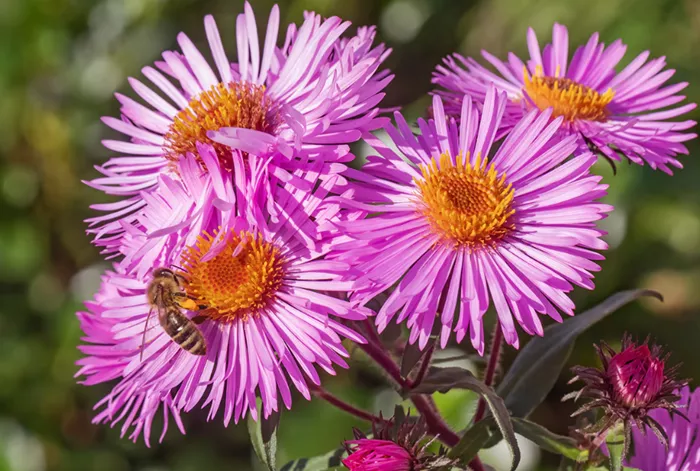In late summer and autumn, Michaelmas daisies, also known as New England asters, bloom beautifully just when they are needed most. Their vibrant, jewel-like colors complement autumn’s fading golds and rich reds, providing a stunning display from late August until mid-October.
Originally introduced to the UK in the early 18th century, these plants were previously known as Aster novae-angliae but have been renamed Symphyotrichum novae-angliae due to genetic research that classified asters into 13 different genera. Many gardeners still refer to them as asters, and plant nurseries may sell them under either name.
Regardless of their name, Michaelmas daisies have several desirable garden traits. They form tight clumps and stand tall, displaying masses of upward-facing daisies in late summer and autumn. Each flower features a central disc surrounded by single or semi-double petals. Colors range from white to pink, cerise, lilac, violet, and blue.
Brian Ellis, a plantsman and nurseryman who previously managed the Plant Heritage National Collection of Symphyotrichum novae-angliae, describes them as having woody stems and limited visual appeal from the bottom. Therefore, they are best placed at the back of borders or among other tall plants and grasses to enhance an otherwise waning display. “As the ultimate bee and butterfly magnets, asters seem to disregard the coming winter,” Ellis noted. The collection is still maintained at Avondale Nursery near Coventry by Gary Leaver. Here are some of Ellis’s favorite varieties:
Recommended Varieties of Michaelmas Daisies
Symphyotrichum novae-angliae ‘Barr’s Blue’
This vigorous plant grows to 1.5 meters tall, featuring large lavender-blue flowers. Ellis highlights its striking appearance but notes it requires plenty of space, as it is as wide as it is tall, making a strong impact in large borders.
S. novae-angliae ‘Purple Dome’
One of the shortest and most compact varieties, it reaches 45 to 60 cm in height and forms a neat dome that is 60 to 90 cm wide. It is covered in vibrant purple flowers and pairs well with the yellows and oranges of rudbeckia, coreopsis, and helenium.
S. novae-angliae ‘Herbstschnee’
This variety features white flowers and grows between 90 cm and 1.2 meters tall, displaying smaller daisies.
S. novae-angliae ‘Andenken an Alma Pötschke’
Known for its vibrant pink blooms, this popular variety can be eye-catching but may require support for its stems.
S. novae-angliae ‘Foxy Emily’
This variety has sophisticated powder-pink daisies with narrow, fingered petals and reaches a height of 1.2 meters.
S. novae-angliae ‘Lachsglut’
This plant produces deep-pink daisies and is suitable for smaller gardens due to its tidy stature. Ellis mentions that this shade of pink blends well with other plants.
S. novae-angliae ‘Rosa Sieger’
Featuring clear rose-pink flowers, this variety harmonizes nicely with surrounding colors and grows to about 90 cm to 1.2 meters tall.
S. novae-angliae ‘Helen Picton’
Named after the National Collection holder at Old Court Nurseries, this variety is a favorite for its intense violet flowers that contrast beautifully with its golden-yellow central disc.
Growing Asters
Aster novae-angliae plants are generally disease-free and resistant to mildew, unlike their shorter relatives, Aster novi-belgii. They require minimal maintenance: cut back plants to the ground after flowering and lift and split aging clumps in spring to rejuvenate growth.
These plants thrive in sunny locations with rich soil that retains moisture. They are typically free from pests and diseases, although occasional rust can be managed by removing affected leaves. Aphids and slugs rarely pose a problem, affecting Aster novi-belgii more often. Mildew is also not a concern, and dividing the plants every three to four years enhances their health and vigor.
For best results, divide or relocate clumps in spring. Taking cuttings early allows them to establish strong plants for winter. While cuttings can be taken, division is usually more reliable.
When planting asters in groups, space them 60 to 90 cm apart, keeping their eventual heights in mind. Applying a layer of organic mulch between clumps at the end of the year helps retain moisture.
You can promote lower-level flowering by using the ‘Chelsea chop,’ which involves removing the growing tips at the front of the clumps. If grown in ideal conditions, staking is typically unnecessary.
Related topics:
- Rescued by Plant Heritage: Two Former At-Risk Plants
- Brandon’s Hill Garden Features a Variety of Flowers
- Two Essential Orchid Care Tasks to Keep Houseplant Flowers Blooming Longer and Thriving for Years


